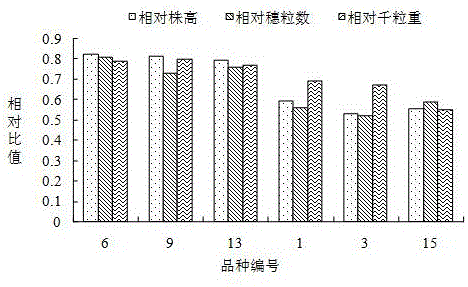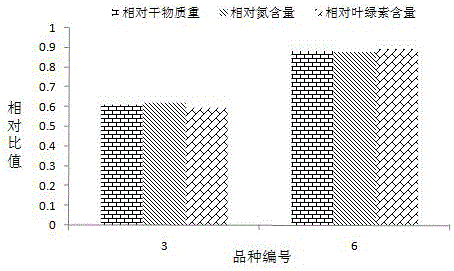Method for screening varieties with high utilization rate of nitrogen from multiple wheat varieties
A high-efficiency, variety-based technology, applied in fertilization methods, horticultural methods, botanical equipment and methods, etc., can solve problems such as large differences in production environments, and achieve the effect of simple and easy operation
- Summary
- Abstract
- Description
- Claims
- Application Information
AI Technical Summary
Problems solved by technology
Method used
Image
Examples
Embodiment
[0048] 1. Obtain plant seedlings
[0049] From the 16 wheat varieties that need to be screened (see Table 3), wheat varieties that are plump and of the same grain size are selected and placed in petri dishes covered with filter paper, and placed in the light incubator to germinate and root the seedlings. After 5 days, Seedlings with consistent growth were selected as experimental treatment materials. The light time is 12 hours during the day and 12 hours at night, the highest temperature during the day is 32°C, and the lowest temperature at night is 27°C.
[0050] Table 3 Numbers of different wheat varieties
[0051]
[0052] 2. Sand culture primary screening
[0053] From the plant seedlings of each variety, 12 seedlings with consistent growth were selected for the sand culture test. The sand cultivation test container is a 29×19cm plastic pot, and the cultivation medium is composed of sand and vermiculite with a volume ratio of 1:1. with deionized water and NH 4 NO ...
PUM
 Login to View More
Login to View More Abstract
Description
Claims
Application Information
 Login to View More
Login to View More - R&D
- Intellectual Property
- Life Sciences
- Materials
- Tech Scout
- Unparalleled Data Quality
- Higher Quality Content
- 60% Fewer Hallucinations
Browse by: Latest US Patents, China's latest patents, Technical Efficacy Thesaurus, Application Domain, Technology Topic, Popular Technical Reports.
© 2025 PatSnap. All rights reserved.Legal|Privacy policy|Modern Slavery Act Transparency Statement|Sitemap|About US| Contact US: help@patsnap.com



